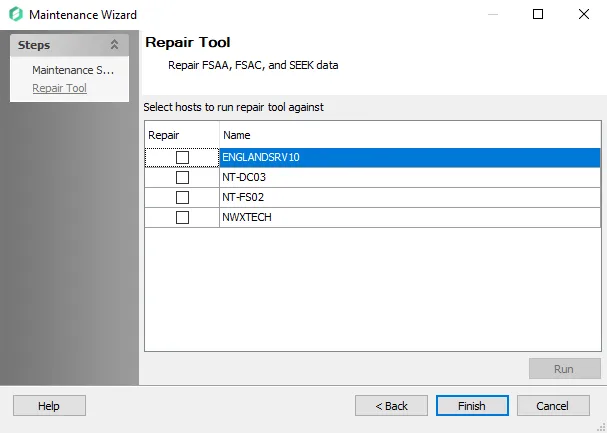FSAA: Query Selection
The FSAA Data Collector Query Selection page contains the following query categories, sub-divided by auditing focus:

-
The File System Access/Permission Auditing options scan hosts for file system information, and there are two categories to choose from:
- Scan – Scans file systems for permission information, ownership, and content profiling
- Bulk import– Imports access scan data into the SQL database
-
The File System Activity options runs user and group activity and inactivity related queries based on FSAC data, and there are two categories to choose from:
- Scan – Performs file system activity scan for the target host
- Bulk import – Imports File System Activity scan data into the SQL database
-
The Sensitive Data options scan hosts for sensitive data, and there are two categories to choose from:
- Scan – Scans file system content for sensitive information
- Bulk import – Imports SDD scan data into the SQL database
-
The DFS options collect Distributed File System information, and there is one category:
-
Scan and import – Collects Distributed File System information
NOTE: Starting with v8.1, DFS Audits are completed with a streaming method and do not require a bulk import query following the scan query.
-
-
The Azure options collects Azure Files storage account information, and there is one category:
- Scan and import – Collects Azure Files storage account information. The instant job preconfigured to use this query category must be used. See the FS_AzureTenantScan Job topic for additional information.
-
The Maintenance options perform maintenance for the FSAA Data Collector, and there are three categories to choose from:
-
Remove scan executables and data – Removes file system access audit scan applet and data from the remote server
-
Upgrade proxy service – Update FSAA binaries for hosts running the File System Proxy Service
NOTE: The Upgrade proxy service category only applies to updating a v8.0+ File System Proxy installation to a newer version. Manual updating is necessary for v7.x File System Proxy installations.
-
Remove Host Data – Removes host from all SQL tables created by the FSAA Data Collector and deletes StrucMap (removes host assigned to job where query exists)
-
Remember, the Sensitive Data category options require the Sensitive Data Discovery Add-On to be installed on the Access Analyzer Console before the FSAA Data Collector can collect sensitive data.
Once a query scan using the FSAA DC has been executed, the Maintenance button is enabled to allow troubleshooting of scan errors that may have occurred.
CAUTION: Do not use the Maintenance button unless instructed by Netwrix Support. It is possible to cause corruption of the database and loss of data to occur.
Maintenance Wizard
The Maintenance Wizard is opened by clicking the Maintenance button on the Query Selection page of the FSAA Data Collector Wizard. You can use the wizard to reset hosts or repair file system data errors.

The Maintenance Selection page allows you to select the type of maintenance to be performed:
- Reset Hosts – Resets the Access GUID column value in the SA_FSAA_Hosts table for the Hosts selected. Allows data to be bulk imported when there is a GUID mismatch.
- Repair – Resets the MinResourceID and MinTrusteeID column values to 0. Removes duplicate and data consistency issues, including resources with nonexistent parents. Deletes StrucMap database.
Select the required option and click Next. The subsequent wizard page is determined by the selection made.
-
If Reset Hosts was selected, the Reset Hosts page displays:

Select the desired hosts to reset the SQL data for, and click Reset Hosts to perform the maintenance.
-
If Repair was selected, the Repair Tool page displays:

Select the desired hosts to repair the SQL data for, and click Run to perform the maintenance.
Click Finish to close the wizard when you have completed the required maintenance.